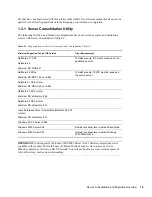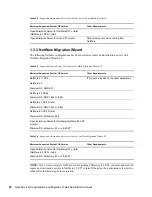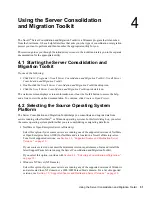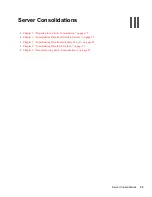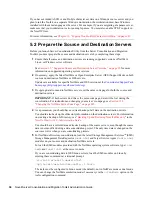
Using the Server Consolidation and Migration Toolkit
4
no
vd
ocx
(e
n)
6 Ap
ril 20
07
31
4
Using the Server Consolidation
and Migration Toolkit
The Novell
®
Server Consolidation and Migration Toolkit is a Windows program that is launched
from the Start menu. It has a helpful interface that asks you what type of consolidation or migration
project you want to perform and then launches the appropriate utility for you.
This section guides you through the introductory screens in the toolkit and refers you to the separate
documentation for the appropriate utility.
4.1 Starting the Server Consolidation and
Migration Toolkit
Do one of the following:
Click
Start
>
Programs
>
Novell Server Consolidation and Migration Toolkit
>
Novell Server
Consolidation and Migration Toolkit
.
Double-click the
Novell Server Consolidation and Migration Toolkit
desktop icon.
Click the
Novell Server Consolidation and Migration Toolkit
quick start icon.
The welcome screen displays version information, an
About the Toolkit
button to access the help,
and a link to view the online documentation. To continue, click
Create or Open Project
.
4.2 Selecting the Source Operating System
Platform
The Server Consolidation and Migration Toolkit helps you consolidate and migrate data from
servers running either NetWare
®
or Windows operating systems. In this first dialog box, you select
the source operating system platform that you are consolidating or migrating data from.
NetWare or Open Enterprise Server (eDirectory)
Select this option if your source servers are running one of the supported versions of NetWare
or Open Enterprise Server (OES) for NetWare and are located in a Novell eDirectory
TM
tree.
For a list of supported versions, see
Section 1.3, “Supported Source and Destination Server
Versions,” on page 18
.
If your source servers do not meet the minimum version requirements, obtain and install the
latest Support Packs before running the Server Consolidation and Migration Toolkit.
If you select this option, continue with
Section 4.3, “Selecting a Consolidation or Migration,”
on page 32
.
Windows NT Server (NT Domain)
Select this option if your source servers are running any of the supported versions of Windows
and are located in an NT domain or a 2000/2003 Mixed Mode domain. For a list of supported
versions, see
Section 1.3, “Supported Source and Destination Server Versions,” on page 18
.
Содержание Server Consolidation and Migration Toolkit 1.2
Страница 4: ...novdocx en 6 April 2007...
Страница 10: ...10 Novell Server Consolidation and Migration Toolkit Administration Guide novdocx en 6 April 2007...
Страница 12: ...12 Novell Server Consolidation and Migration Toolkit Administration Guide novdocx en 6 April 2007...
Страница 26: ...26 Novell Server Consolidation and Migration Toolkit Administration Guide novdocx en 6 April 2007...
Страница 30: ...30 Novell Server Consolidation and Migration Toolkit Administration Guide novdocx en 6 April 2007...
Страница 34: ...34 Novell Server Consolidation and Migration Toolkit Administration Guide novdocx en 6 April 2007...
Страница 64: ...64 Novell Server Consolidation and Migration Toolkit Administration Guide novdocx en 6 April 2007...
Страница 74: ...74 Novell Server Consolidation and Migration Toolkit Administration Guide novdocx en 6 April 2007...
Страница 92: ...92 Novell Server Consolidation and Migration Toolkit Administration Guide novdocx en 6 April 2007...
Страница 110: ...110 Novell Server Consolidation and Migration Toolkit Administration Guide novdocx en 6 April 2007...
Страница 120: ...120 Novell Server Consolidation and Migration Toolkit Administration Guide novdocx en 6 April 2007...
Страница 126: ...126 Novell Server Consolidation and Migration Toolkit Administration Guide novdocx en 6 April 2007...
Страница 128: ...128 Novell Server Consolidation and Migration Toolkit Administration Guide novdocx en 6 April 2007...



